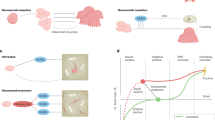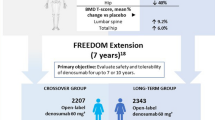Abstract
Being a connective tissue, bone can increase or decrease its mass through the process of remodeling. Using a discovery in the mid-1980s—that tumor necrosis factor (TNF) could dramatically increase formation of osteoclasts (the cells that break down bone)—researchers at Amgen (Thousand Oaks, CA) discovered a TNF-like molecule that regulated bone resorption. Elevations in the expression of this molecule, receptor activator of nuclear factor-κB ligand (RANKL), can cause excessive bone destruction. A blocking antibody to RANKL named denosumab inhibits osteoclast formation and bone degradation. In a large multicenter clinical trial, known as the FREEDOM trial (Fracture Reduction Evaluation of Denosumab in Osteoporosis Every 6 Months), the effects of denosumab were tested in 60- to 90-year-old women over 3 years. Statistically significant reductions in fracture risk at the vertebral column, hip, and nonvertebral sites were associated with increases in bone mineral density (BMD) and reciprocal decreases in markers of bone resorption. However, the FREEDOM trial did not test the most beneficial use of a resorption blocking drug—to target the rapid bone loss that occurs in late perimenopause and early postmenopause. One adverse effect from denosumab is cellulitis, and research in animals suggests that RANKL/RANK interaction is needed for Langerhans cell (LC) survival in the skin. Further mechanistic and clinical studies on the role of RANKL in the skin are needed.

Similar content being viewed by others
References
Bertolini DR, Nedwin GE, Bringman TS, et al.: Stimulation of bone resorption and inhibition of bone formation in vitro by human tumour necrosis factors. Nature 1986, 319:516–518.
Simonet WS, Lacey DL, Dunstan CR, et al.: Osteoprotegerin: a novel secreted protein involved in the regulation of bone density. Cell 1997, 89:309–319.
Lacey DL, Timms E, Tan HL, et al.: Osteoprotegerin ligand is a cytokine that regulates osteoclast differentiation and activation. Cell 1998, 93:165–176.
Randolph JF Jr, Sowers M, Bondarenko IV, et al.: Change in estradiol and follicle-stimulating hormone across the early menopausal transition: effects of ethnicity and age. J Clin Endocrinol Metab 2004, 89:1555–1561.
Sowers MR, Jannausch M, McConnell D, et al.: Hormone predictors of bone mineral density changes during the menopausal transition. J Clin Endocrinol Metab 2006, 91:1261–1267.
Iqbal J, Sun L, Kumar TR, et al.: Follicle-stimulating hormone stimulates TNF production from immune cells to enhance osteoblast and osteoclast formation. Proc Natl Acad Sci U S A 2006, 103:14925–14930.
Sun L, Peng Y, Sharrow AC, et al.: FSH directly regulates bone mass. Cell 2006, 125:247–260.
Cummings SR, San Martin J, McClung MR, et al.: Denosumab for prevention of fractures in postmenopausal women with osteoporosis. N Engl J Med 2009, 361:756–765.
Genant HK, Engelke K, Hanley DA, et al.: Denosumab improves density and strength parameters as measured by QCT of the radius in postmenopausal women with low bone mineral density. Bone 2010, 47:131–139.
Iqbal J, Zaidi M: Understanding estrogen action during menopause. Endocrinology 2009, 150:3443–3445.
Fata JE, Kong YY, Li J, et al.: The osteoclast differentiation factor osteoprotegerin-ligand is essential for mammary gland development. Cell 2000, 103:41–50.
Theill LE, Boyle WJ, Penninger JM: RANK-L and RANK: T cells, bone loss, and mammalian evolution. Annu Rev Immunol 2002, 20:795–823.
Leibbrandt A, Penninger JM: Novel functions of RANK(L) signaling in the immune system. Adv Exp Med Biol 2010, 658:77–94.
Leibbrandt A, Penninger JM: RANK/RANKL: regulators of immune responses and bone physiology. Ann N Y Acad Sci 2008, 1143:123–150.
Barbaroux JB, Beleut M, Brisken C, et al.: Epidermal receptor activator of NF-kappaB ligand controls Langerhans cells numbers and proliferation. J Immunol 2008, 181:1103–1108.
Ferron M, Wei J, Yoshizawa T, et al.: Insulin signaling in osteoblasts integrates bone remodeling and energy metabolism. Cell 2010, 142:296–308.
Hirao M, Hashimoto J, Ando W, et al.: Response of serum carboxylated and undercarboxylated osteocalcin to alendronate monotherapy and combined therapy with vitamin K2 in postmenopausal women. J Bone Miner Metab 2008, 26:260–264.
Hanada R, Leibbrandt A, Hanada T, et al.: Central control of fever and female body temperature by RANKL/RANK. Nature 2009, 462:505–509.
Iqbal J, Sun L, Zaidi M: Coupling bone degradation to formation. Nat Med 2009, 15:729–731.
Tang Y, Wu X, Lei W, et al.: TGF-beta1-induced migration of bone mesenchymal stem cells couples bone resorption with formation. Nat Med 2009, 15:757–765.
Acknowledgments
Drs. Mone Zaidi and Li Sun are supported by grants from the US National Institutes of Health. Dr. Jameel Iqbal acknowledges the support of the American Federation for Aging Research.
Disclosures
Dr. Zaidi consults for Genentech, Amgen, and Warner Chilcott. Dr. Zaidi is also a named inventor of a pending patent application related to osteoclastic bone resorption filed by the Mount Sinai School of Medicine (MSSM). In the event the pending or issued patent is licensed, he would be entitled to a share of any proceeds MSSM receives from the licensee. No other potential conflicts of interest relevant to this article were reported.
Author information
Authors and Affiliations
Corresponding author
Rights and permissions
About this article
Cite this article
Iqbal, J., Sun, L. & Zaidi, M. Denosumab for the Treatment of Osteoporosis. Curr Osteoporos Rep 8, 163–167 (2010). https://doi.org/10.1007/s11914-010-0034-z
Published:
Issue Date:
DOI: https://doi.org/10.1007/s11914-010-0034-z




